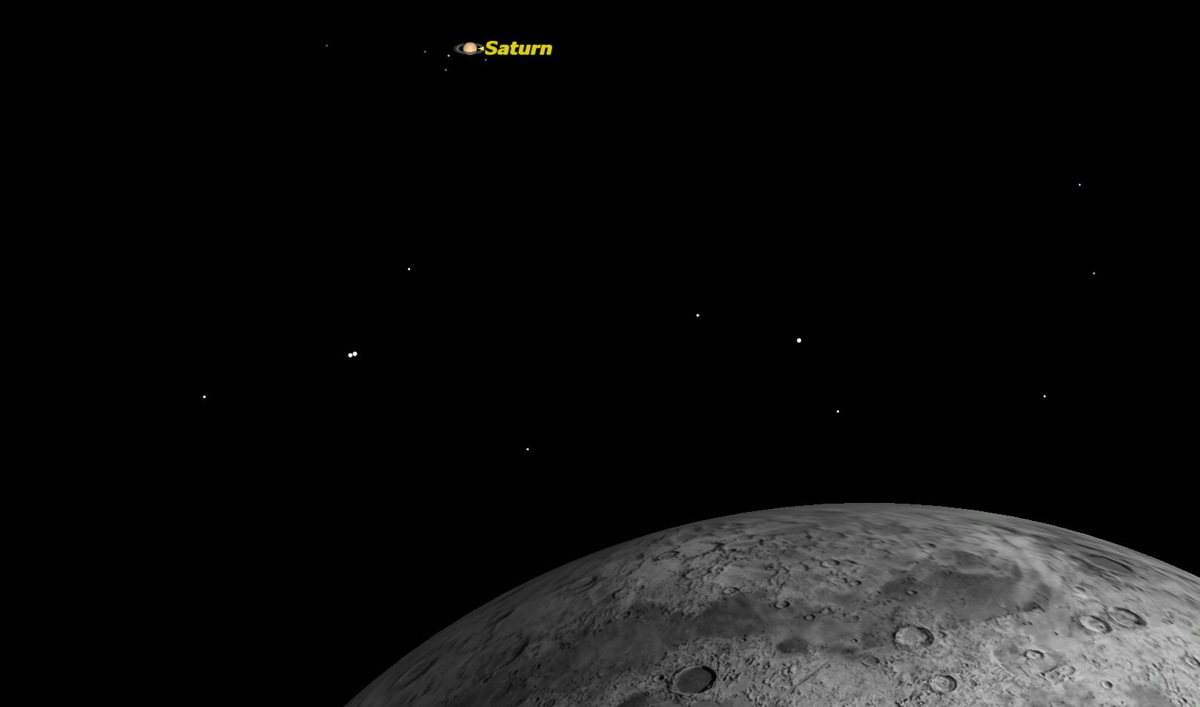
Look up tonight (July 7) to spot Saturn hovering very close to the moon.
With its immediately recognizable rings, Saturn might be one of the most striking planets in the solar system, but many skywatchers find it hard to spot the planet in the night sky. Venus and Jupiter can be immediately identified by their great brilliance, as can Mars by its distinctive fiery orange color. But to the naked eye, there really isn't anything distinctive about Saturn.
It appears as a bright "star" shining with a steady, sedate, yellow-white glow, but it really isn't all that eye-catching. Indeed, many neophytes to astronomy may have passed over the planet visually without knowing exactly what it was. Tonight, however, it will be easier than usual to pick out the ringed wonder. [Best Skywatching Events of July 2014 (Sky Maps)]
As darkness falls, and if weather permits, look toward the south-southwest sky. Roughly one-quarter up from the horizon to the point overhead will be a waxing gibbous moon. Incidentally, this is the best time to look at the moon with binoculars or a telescope, because it offers more viewing comfort to the eye as opposed to a full moon. Using a telescope with just small optical power (magnifications of 20x to 40x), or even with good binoculars, you can then see a wealth of detail on the moon's surface.
Hovering just over a degree above the moon will be a bright, yellowish-white "star" shining with a steady glow. That is Saturn. Now, with Saturn properly identified, you can try using a telescope on the planet, sometimes referred to as one of the grandest sights of the night sky.
Anyone who has seen Saturn through a telescope remembers that first view. The magnificent ring system, the banded globe and its faintly shimmering moons make Saturn an object of exquisite beauty. The most dramatic aspects of the celestial body are probably its rings. Any telescope magnifying more than 30-power will show them.
A four-inch telescope at 100x or an 8-inch telescope at 200x will provide a memorable view. The rings consist of billions of particles ranging in size from sand grains to flying mountains, which are made of — or covered by — water ice. This accounts for their very high reflectivity.
Get the Space.com Newsletter
Breaking space news, the latest updates on rocket launches, skywatching events and more!
Right now, the north sides of the rings are tilted 21 degrees toward Earth. They haven't been this wide open in eight years, so now is a good time to check them out.
And if you happen to be situated somewhere in the lower-third of South America, you'll actually be able to see the moon cross in front of Saturn — called an occultation — at around 0200 July 8 GMT (which would correspond to 10 p.m. EDT tonight).
During the next several weeks, the planet Mars, which hovered even closer to the moon's upper limb on Saturday night, will approach Saturn. By the end of August, the two planets will make for an eye-catching configuration in the early evening sky.
Editor's Note: If you have an amazing skywatching photo of Saturn or any other night sky view you'd like to share for a possible story or image gallery, please contact managing editor Tariq Malik at spacephotos@space.com.
Joe Rao serves as an instructor and guest lecturer at New York's Hayden Planetarium. He writes about astronomy for Natural History magazine, the Farmer's Almanac and other publications, and he is also an on-camera meteorologist for News 12 Westchester, N.Y. Follow us @Spacedotcom, Facebook and Google+. Original article on Space.com.
Join our Space Forums to keep talking space on the latest missions, night sky and more! And if you have a news tip, correction or comment, let us know at: community@space.com.

Joe Rao is Space.com's skywatching columnist, as well as a veteran meteorologist and eclipse chaser who also serves as an instructor and guest lecturer at New York's Hayden Planetarium. He writes about astronomy for Natural History magazine, Sky & Telescope and other publications. Joe is an 8-time Emmy-nominated meteorologist who served the Putnam Valley region of New York for over 21 years. You can find him on Twitter and YouTube tracking lunar and solar eclipses, meteor showers and more. To find out Joe's latest project, visit him on Twitter.









